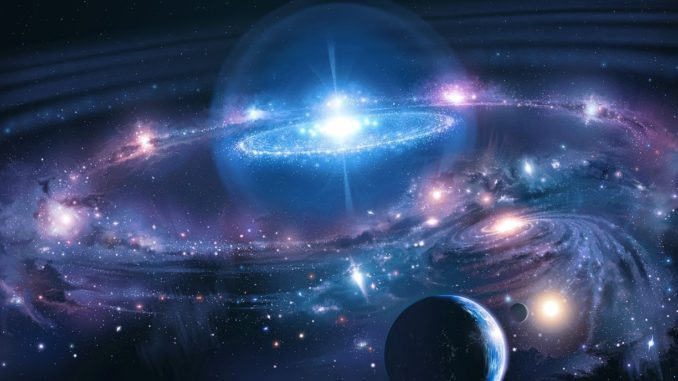
I’ve been toying around with a fantasy setting for the past while. I’ve got a lot of the big pieces that I want to include, but I’ve been trying to figure out how to make it something more unique and not just another fantasy setting that we’ve seen before, and I think I’ve finally hit on the angle at a macro level that lets it stand out while still being usable in just about any fantasy setting without requiring much in the realm of house rules.
A concept that I don’t see very often in fantasy games is the idea of the setting being one world in a greater galaxy. It may be implied that there are other planets in the vastness of space, but they don’t usually receive a lot of attention beyond that and instead use the planar structure to introduce some of the truly alien beasts that may inhabit the setting. I’m sure it wasn’t the first to incorporate a greater solar system with inhabited planets, but my first real exposure to it was with the Pathfinder campaign setting of Golarion which was then, of course, expanded on and became the implied setting for the Starfinder game. I decided to adopt this approach for my setting for a number of reasons –
Deities
If the universe is large enough, it can explain the presence of multiple pantheons of deities as well as other cosmic beings that may be worshiped by various faiths and cults. With each of these powers having access to the same elements of creation within the planar structure and multiple worlds that can be established as viable homes, there is no reason that multiple, even contradictory faiths can exist. It also gives immediate significance to the “standard” pantheon that is worshiped on the planet the PCs will be playing in – why are they the standard pantheon? What events happened in the creation story that prompted these beings to become elevated and recognized above these other cosmic powers? Whether it’s creation of certain species or protecting the world from some form of armageddon engineered by another power, they become important to the setting.
Significance of the World
What makes the settings of these various fantasy worlds significant beyond the fact that they are the implied settings of the games that operate within those settings when there are likely hundreds of thousands of other worlds surrounding their own stars that host their own forms of life and have their own histories, heroes, and importance? Approaching your cosmology from this level allows you to assign this significance within the world building. For example, in the setting that I am working on, Alesia (the “home” planet that the PCs will be a part of) was placed at the one point in the universe that the various ley lines and magical energy fields intersected. These energies suffuse the planet filling it with a potential that is unable to rivaled by any other planet. The gods that created it had to fight hard in order to win their claim and must work hard to guard it against other jealous deities.
Actual Aliens
Providing other planets and other cosmic beings allow you to truly define where certain types of creatures that are so bizarrely aberrant to the human experience come from. Take a look for example at the Illithids as they have been presented in various editions of the Dungeons and Dragons roleplaying game – they have at times been creatures from the Far Realm, a plane of reality that is utterly alien and incomprehensible to the human mind. In the latter part of Edition 3.5, Lords of Madness stated that they were, in fact, a starfaring race of people and even capable of time travel. This fact was supplanted once again by the idea that they were simply creatures from the Far Realm in more recent editions of the game.
By having other planets that creatures like Illithids, Aboleths, and even the Fey call home, you can establish them as different without having to get into a dizzying number of planar realms and realities and retconning. And if you have established the significance of the homeworld of your campaign setting as discussed above, it gives you a reason for these other creatures to find a way to visit, either through travel through the transitive planes, magical gates, or the possibility of starfaring ships (if that fits the milieu of your game). Once again, in the setting that I’m working on, the sheer potential of the power that existed within the planet of Alesia was more than enough to draw the attention of other alien races that could sense the power. And when that power was the center of a cataclysm that affected the balance of the entire planar structure, it put attention on Alesia by other powers that may not have been interested in it before but have now been adversely affected by the actions of the people of Alesia.
Next week I’ll take a look into the actual form I decided for the “inner sphere” of the planar structure for my setting to give you all a taste of what I’m working with.
